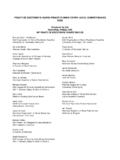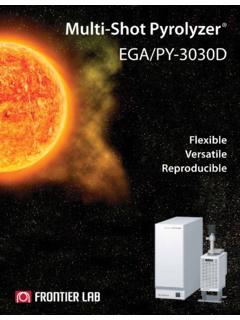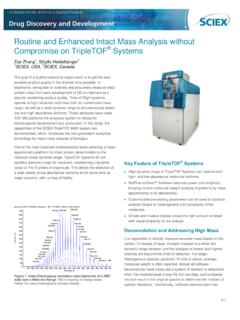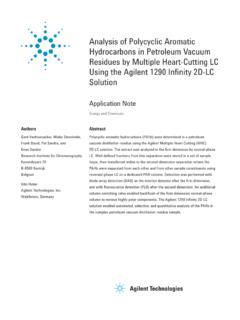Transcription of STANDARD OPERATING PROCEDURE FOR …
1 STANDARD OPERATING PROCEDURE FOR MANUAL INTEGRATION Applicable Matrix or Matrices: NA STANDARD Compound List and Reporting Limits: NA Approvals and Signatures Laboratory Director: _____ Date:_____ Christopher A. Ouellette QA Manager: _____ Date:_____ Kim B. Watson Organics Technical Director: _____ Date:_____ Bryce E. Stearns Inorganics Technical Director: _____ Date:_____ Kristine A. Dusablon GC Supervisor: _____ Date:_____ David P. Downing Organic Prep Manager: _____ Date:_____ Jon K. Zygmuntowicz This documentation has been prepared by STL Burlington (STL) solely for STL's own use and the use of STL's customers in evaluating its qualifications and capabilities in connection with a particular project. The user of this document agrees by its acceptance to return it to STL upon request and not to reproduce, copy, lend, or otherwise disclose its contents, directly or indirectly, and not to use if for any other purpose other than that for which it was specifically provided.
2 The user also agrees that where consultants or other outside parties are involved in the evaluation process, access to these documents shall not be given to said parties unless those parties also specifically agree to these conditions. THIS DOCUMENT CONTAINS VALUABLE CONFIDENTIAL AND PROPRIETARY INFORMATION. DISCLOSURE, USE OR REPRODUCTION OF THESE MATERIALS WITHOUT THE WRITTEN AUTHORIZATION OF STL IS STRICTLY PROHIBITED. THIS UNPUBLISHED WORK BY STL IS PROTECTED BY STATE AND FEDERAL LAW OF THE UNITED STATES. IF PUBLICATION OF THIS WORK SHOULD OCCUR THE FOLLOWING NOTICE SHALL APPLY: (c)COPYRIGHT 2000 STL BURLINGTON. ALL RIGHTS RESERVED. PURPOSE This STANDARD OPERATING PROCEDURE provides guidance on the proper way to integrate chromatographic peaks. Integration of peak areas is commonly required to relate instrument response to component concentration in Gas and Liquid Chromatography.
3 Chromatographic data systems can be set up to detect and measure peak areas automatically. Automatic integration is preferred because it is fast and in most cases, very consistent. Proper instrument and integration parameter set-up facilitates automatic integration. Consistency in integration between standards and samples is one of the most important considerations in quantitative chromatographic analysis. Baseline upsets, coelution and peak shape variation can sometimes complicate automatic integration and analyst intervention through the process of manual integration may be required to assure consistency between area assignment for standards and samples. Examples of proper and improper integration can be found in Section 4. POLICIES Proper consistent manual integration is a critical quality control requirement.
4 Appropriate manual integration is integration that can be technically justified. Integration below the baseline is never appropriate. Inappropriate and inconsistent chromatographic peak integration to meet quality requirements is never allowed, nor is it to be used as a substitute for corrective action on the chromatographic system. Inappropriate peak integration used to meet quality control criteria is grounds for dismissal. Manual integration must be documented by chromatograms showing the integration by the machine and by the manual process. Analysts are required to have knowledge of these commands for their particular instruments. SAFETY ISSUES The toxicity or carcinogenicity of each reagent used in this method has not been fully established. Each chemical should be regarded as a potential health hazard and exposure should be as low as reasonably achievable.
5 Cautions are included for known extremely hazardous materials or procedures. STL maintains a current awareness file of OSHA regulations regarding the safe handling of the chemicals specified in these methods. Material Safety Data Sheets (MSDS) are made available to all personnel involved in the chemical analysis. STL also has a written environmental health and safety plan. Please note chemicals that have the potential to be highly toxic or hazardous, the appropriate MSDS must be reviewed by the employee before handling the chemical. PROCEDURES Chromatograms are plots of detector signal as a function of the time. Compounds are detected as peaks. It is necessary to determine the chromatographic baseline signal and the start and stop points of the peaks along the baseline. Each chromatographic data system has a particular set of integration instructions to manually assign start and stop points once they have been determined.
6 Assignment of proper peak start and stop times along the baseline are illustrated in this SOP. Properly integrated simple chromatographic peak . Properly integrated fused peaks. Properly integrated skimmed peak and properly integrated tailing peak . Properly integrated overload peak ( benzoic acid on DB-5). Properly integrated peak on baseline rise. Properly integrated peak near a baseline upset. Properly integrated fused tailing peak (very difficult to accurately quantify). Do maintenance on chromatography system to avoid if possible). Properly integrated split peaks (from same compound). Properly integrated peak with unresolved shoulder Properly integrated hydrocarbon envelope. Properly integrated specific compound on an envelope ( a surrogate on top of a hydrocarbon envelope).
7 Improperly integrated peak with unresolved shoulder. Improperly integrated specific compound on an envelope ( a surrogate on top of a hydrocarbon envelope). Improperly integrated peaks. Reasons to Manually Integrate. Undetected peak : Routine mass spectrometer instrument tuning or the analysis of highly contaminated samples sometimes causes the relative abundances of ions of compounds present to deviate from reference criteria causing a peak to go undetected by the data system. A slight shift in chromatographic retention times can result in undetected peaks or false positive identification of compounds. Incorrect peak Integration * peak has small amount of splitting and the whole peak area was not integrated. * Peaks close in retention times utilizing the same quantitation ions, (ethylbenzene, xylenes; dichloro-benzenes) often integrate together as one peak .
8 Matrix Interference * Integration of indistinguishable groups of peaks which cannot be identified singularly. * Baseline interferences caused by contaminated samples may interfere with calibrated compounds. PROCEDURE for Manual Integration. The data processing system (Target for GC/MS, and multi-chrom for GC) has an integration option and can locate any peak specified by the user. The analyst can choose to integrate the peak as needed and examine the mass spectra at each part to verify proper identification. The area count or height is automatically calculated when a peak has been integrated. RESPONSIBILITIES It is the responsibility of the analyst to document manual integrations in the following manner: A ion chromatographic trace of the signal for the peak used for quantitation after manual integration has been performed must be supplied, with the reason (if not clear from the supplied selected ion chromatogram), date and initials of the analyst.
9 The reason supplied for the manual integration may be numerically designated using the list below. Number Reason M1 peak missed M2 Mis-identification of the peak ( 1,4-dichlorobenzene identified as 1,3-dichlorobenzene) M3 Poor automated baseline construction M4 Special requirement ( have to calculate surrogatefrom a hydrocarbon envelope M5 Other - Explain in narrative A second review and approval of the manual integration for any compound of a quality criteria STANDARD must be performed, dated and initialed. Quality criteria standards are MDLs, initial calibrations, continuing calibrations, second source standards, surrogates, internal standards, matrix spikes, matrix spike duplicates, blank spikes, blank spike duplicates and laboratory control standards. This second review may be carried out by the Section Supervisor, Data Reviewer or Laboratory Manager.)
10 The QA Manager or designee will spot check manual integrations during internal and data audit process. This review must also be dated and initialed. DEFINITIONS Integration - The process of determining area under a curve (ie a peak ). Chromatography - A separation technique involving differential retention of components between stationary and mobile phases. Baseline - The chromatographic signal plotted as a function of time in the absence of signal construction from components of interest. peak - An increase in signal from baseline to a maximum and then back to baseline. Coelution - The concurrent elution of two or more compounds to the detector at the same time. Elution - The process of movement of compounds from the chromatographic system. "Wavy" Baselines: A undulating baseline can be caused by minor impurities in the carrier gas or solvent.













